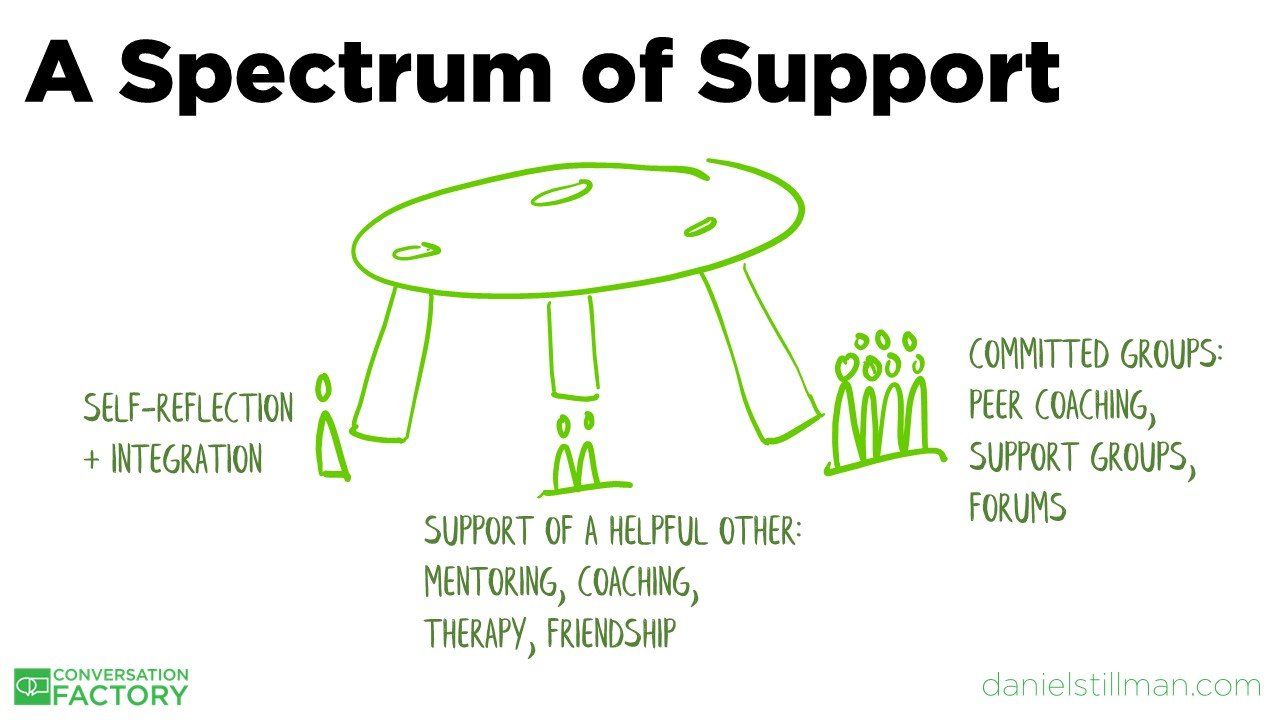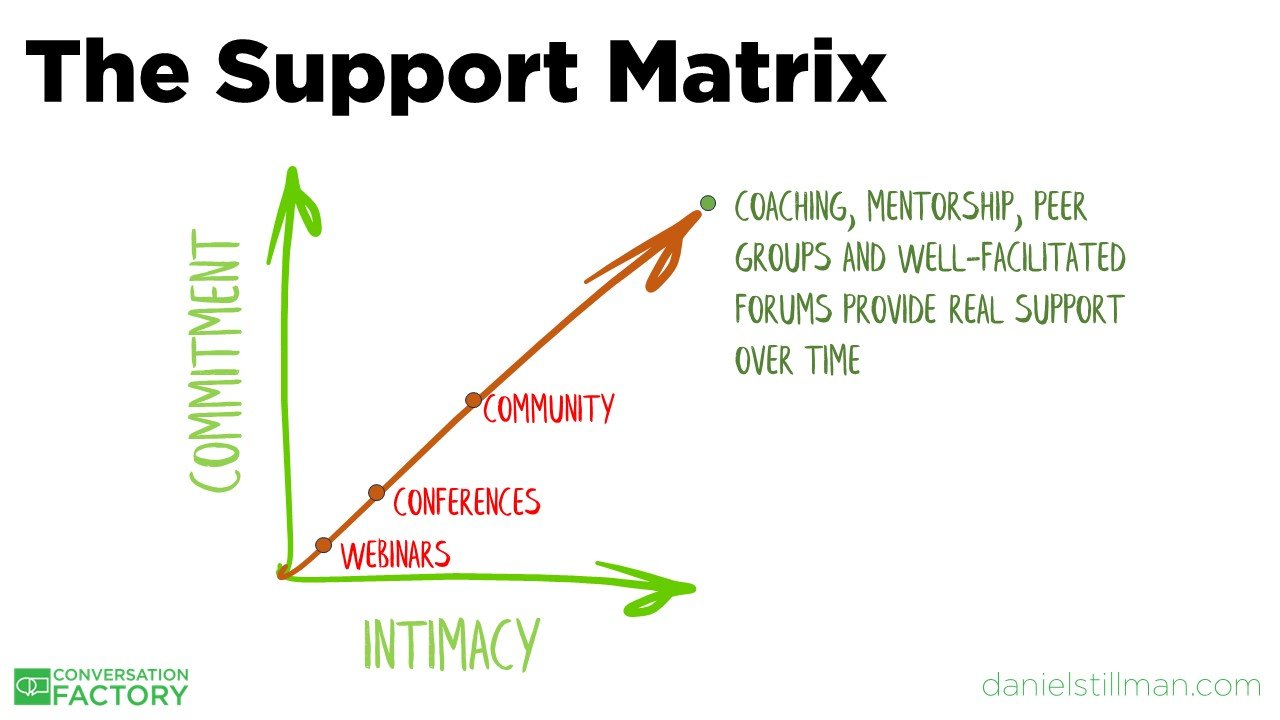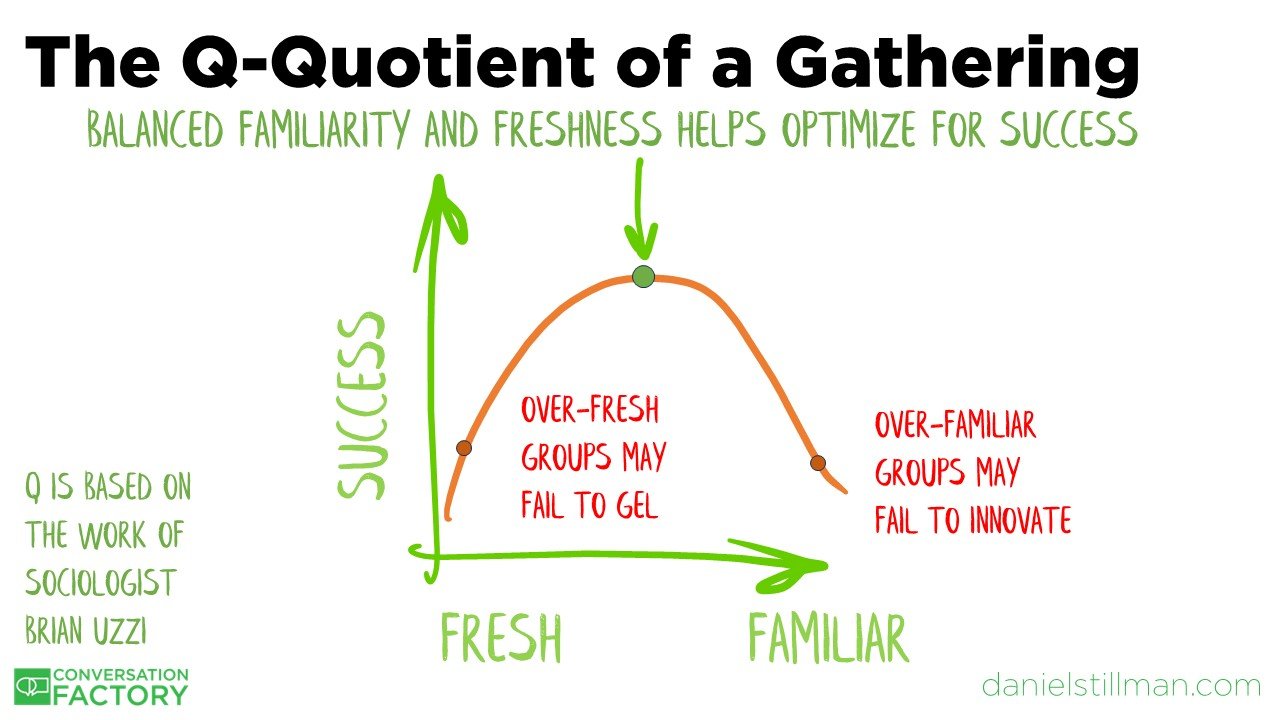In early May of 2023, the surgeon general of the US released an advisory report calling attention to the loneliness epidemic.
If you’re new to this topic, in short, people today have fewer friends and fewer systems of support than ever before.
Why is this important?
At a societal level, if a population is lonely and disconnected, you’re going to see the impacts in an uptick of negative health outcomes from an increased incidence of heart disease to increases in suicides - that’s why it’s so powerful that the surgeon general is weighing in on this.
Why is this important to you, the reader, in your life?
How much support does a person need?
Some ages back, I wrote about how founders can’t emotionally bootstrap their companies.
Since I wrote that essay, that perspective has been reinforced and expanded through many, many conversations I’ve had with founders and leaders who tell me that they need a whole spectrum of support to sustain themselves, their companies and their relationships.
For example, my podcast conversation with the co-founders of the next-gen gaming platform Artie confirmed that having a coach and a therapist is totally a thing, and nothing to be ashamed about!
What kind of systems of support?
For me, I have a five-legged stool of support systems, regular conversations and gatherings that are blocked in my calendar.
My Therapist (one hour weekly, on and off for 15+ years)
My Men’s Group (two hours weekly, four years strong)
My Coaching Forum (five hours monthly, currently entering our third year)
My Sunday Dinner + Drinks (2-3 hours weekly…this dinner with friends has been going strong for over 10 years).
My journaling and sketching habit - sometimes daily, sometimes less. I have notebooks for my mental health and for my coaching practice.
But we could bucket these into a basic spectrum of support, sized like t-shirts: Large, Medium and Small. The three key conversational buckets, or legs of support are:
Groups,
One-on-one conversations, and
Conversations with myself
Now, I love sorting conversations by size, ie, amount of people, as the Spectrum of Support stool diagram does above, but we could just as easily sort these spectrums of support with many other lenses.
For example:
Self/peer facilitated vs expertly facilitated. My therapist is accredited and expert in their field, while my men’s group and coaching forum are peer-facilitated. It’s great to have self/peer facilitated spaces because guiding conversations is such a critical leadership skill, and these spaces can create opportunities to hone your own approach. Experts, on the other hand, bring safety, clarity and assurance to their approach, and I always learn something new I can steal!
Self-growth focus vs Life Focus: My Sunday dinner conversations are sometimes about life, the universe and everything, but often we talk about media, politics, and other tomfoolery. On the other hand, my men’s group is only focused on personal growth and self-transformation. We don’t talk about stories, we process emotions. I find safety and security in knowing that I have a space like my men’s group that will always be laser focused, vs a space that is flexible and loose.
Self/Others/Nature/Transcendence: My friend and podcast guest Casper ter Kuile uses four very different categories, when he describes rituals that foster connection. Ritual can simply mean “a way to create space and time for something that matters.” He thinks about:
rituals for connecting with yourself,
rituals that connect you to others
rituals for fostering connection to nature
rituals that create time to connect with something transcendent, which for some might be a sense of “god”, oneness, or something else.
Since he’s largely inspired by what I like to call “Biomimicry but using religion” it’s not surprising that he includes time for focusing on something larger than what we can see with our eyes - connection with the transcendent is a feature of all religions. Connecting with something bigger than ourselves helps inspire awe and wonder, both surprisingly helpful experiences. His company, The Sacred Design Lab explores what we can learn from religion to inspire leadership, gathering and transformation and he wrote a wonderful book on the power of ritual. You can check out our conversation here!
Why is regular, even structured, self-talk so important? Check out my essay here on how impactful self-talk can be on your quality of life. In short, how you talk to and with yourself is the fundamental rate-limiter of your overall success and happiness.
The Commitment-Intimacy Support Matrix
The spectrum that has been on my mind is at the intersection of commitment and intimacy - what I am currently focusing on as the essential factors in any Support Matrix.
I began to realize that the systems of support, the spaces and places that had delivered the most impact to me were all high-commitment and high-intimacy spaces.
For example: My men’s group is a high-commitment space - we commit to coming together each week. If we need to miss a session, we have to reach out to other members and have a 1-1 check in with someone to share what we’re making more important than the meeting.
(Note - it’s 100% okay to say - “I am prioritizing going to a party with my partner” - and committing to being 100% present to having a great time at said party and coming back and sharing that joy with the group!)
Since we’re a high-commitment space, you can’t just flake out. If you do, we’ll call you out on breaking your commitments. We’re also high-intimacy, in the sense that we can bring anything to the group to talk about - it’s one of the few spaces where we can say whatever we need to.
My coaching forum is also a high-intimacy space. Even though we focus on helping each other grow our coaching practice (both in professional excellence and revenue) we also focus on sharing what is really going on in our lives - losses of family members, parenting, fertility journeys, self-doubt, and so on.
Often I see people trying to learn, develop and grow using low-commitment and low-intimacy spaces: Webinars, reading, social media.
These are like snacks. They can keep you alive and moving forward, but they are just not enough.
Deeper commitment is more deeply nourishing.
Deeper intimacy, allowing yourself to really be seen and to see others, is powerful.
The Holy Trinity of Professional Development: Coaching, Mentoring and Peer Forum
With my executive coaching clients, I find there is a powerful trinity of support systems they need to thrive in their roles: Coaching, Mentoring, and Peer Forums.
Sometimes these support systems are more ad-hoc and casual, but I’ve found that they are all like 401ks - the value of commitment and intimacy compounds over time as you reinvest.
Coaching is powerful because it focuses on the belief that the coachee has the answer within, that they can and should find their own way. It creates the space and time for them to think deeply, with a caring and committed thought partner (like me! - learn more about my coaching here).
Coaching is less directive, which means the coachee can tap into their own reserves in a powerful way.
Mentoring is powerful because it helps a leader get vital feedback and information about their unique context. No matter how much confidence and clarity a person can get from coaching, it is incredibly helpful to connect with someone who’s “been there/done that” in some relevant way. Finding great mentors (plural - the more the better) is hard, but worthwhile.
Peer Forums can go by lots of different names: Peer Coaching, Peer Exchange Groups, Masterminds. Organizations like EO, YPO, Starting Bloc, and Vistage host peer groups that are powerful in five ways:
They are long (in duration - for example, YPO-style groups meet monthly for a full day in person, while my coaching peer group meets monthly for five hours online.
They are ongoing - they usually continue to meet with no end date in sight.
They are small - often capped at 10 people - which feeds intimacy.
They are highly structured. Either they are expertly facilitated or the people in the group are expertly trained to self-facilitate.
They are normalizing. When the group is more similar than different in essential ways, they can provide deeply nourishing feedback that, yes, the challenge you are facing is face-able, since others have also faced it in some manner.
Balancing Diversity with Similarity in Support Systems
Balancing variety and diversity with similarity and familiarity is essential, and also a fundamental challenge of peer groups, coaching and mentoring.
For example - in my men’s group, it's very powerful that some of us are dads, some of us are trying to become dads, and some of us never want kids. It provides richness to the conversation.
On the other hand, when someone is struggling with parenting, it’s incredibly helpful for someone else in the group to be able to say, “I see you,” from having had a similar experience.
On the other hand, there are men’s groups only for dads - having someone who never wants kids in such a group just makes no sense!
Similarly, it can be helpful for a CEO group to only have CEOs or for a CTO group to just have CTOs, but it can be very helpful for them to be in different industries and stages of growth. On the other hand, the peer groups in EO, YPO and others often work to create groups that are in similar stages of development.
Filtering in this way can have advantages …but also drawbacks: too much sameness sucks the richness from the conversation.
How can we find the sweet spot between diversity and similarity?
The Q of a gathering
In 2012, Jonah Lehrer wrote a wonderful article in the New Yorker about Groupthink. In the later half of the article, he discussed the work of Brian Uzzi, a sociologist at Northwestern, who dedicated his career to uncovering the ideal team composition. He focused on Broadway musicals as an ideal way to study the complex ways team creativity can impact success, with easy to measure inputs (people) and outputs (box office numbers!).
Musicals, to Uzzi, epitomize group creativity. Collaboration is paramount – composers work with lyricists, choreographers with directors, etc. - to create a successful show. Uzzi studied all 474 Broadway musicals from 1945 to 1989, tracking relationships and using a value he called "Q" to measure the amount of social connectivity and familiarity a team had.
Often musicals are developed by teams of artists that have worked together several times before—a common practice to reduce risk with “known quantities." We still see this today in marketing “from the team that brought you X.” Such musical productions would have a relatively high Q. A musical created by a team of strangers would have a low Q.
Uzzi, in essence, compared familiarity with success and reported:
“Frankly, I was surprised by how big the effect was…I expected Q to matter, but I had no idea it would matter this much.”
A low Q (low familiarity, or an overly-fresh team) correlated with low success, which Uzzi expected - it may take time to develop a successful collaboration. What was surprising was that a very high Q was also correlated with low success!
It was possible to be too familiar.
Lehrer summarized Uzzi’s insight:
“The artists all thought in similar ways, which crushed innovation.”
I love this idea of balancing freshness and familiarity in all our gatherings, not just in the success of musicals or the general creativity of teams.
I have seen this play out in my own life - I have an annual eggnog party where I make a quadruple batch of the New York Times classic Nog. It’s been going for about ten years, with a small break for the pandemic. In the before-times, the gathering was often a familiar group of groups from my life - grad school, work, other friends, who knew each other a bit, and more and more over the years. It was always a large and raucous group, but our Q was increasing too much, as it turned out. I had created a guest list that was more regulars than new additions. (although the addition of my wife about five years ago did provide a solid Q-infusion since she has fun friends!)
Last year, I started hosting a series of smaller salon-like gatherings dedicated to serendipity. My wife and I split the invite list and started reconnecting to old acquaintances and new folks we were meeting as we ventured out in the post-pandemic re-socializing of New York. Some folks would get re-invited, others were one-offs. After hosting just 2-3 of these gatherings, the dates of the Egg Nog party approached. We decided to invite everyone who had been to a salon and the whole old timers Nog list.
The group that wound up coming to Nog Fest 2022 had a really great Q-value. A solid balance of freshness and familiarity that everyone commented on.
Similarly, in peer groups, we can be tempted to find a group that all narrowly meet a certain criteria or be a certain type to create a maximal Q-value. But Uzzi’s Q research shows us that variety is the spice of life, and that cultivating diversity of many types can have outsized rewards.
We are social animals and we require varied social nourishment
As a professional, I focus a lot on my own professional development and on helping my clients develop themselves. But, of course, we’re more than just our work.
This is where the conversation moves into the ideas of third places, long-term conversations, and, the importance of clubs in helping us stay connected to each other (which is what the film by my friend Rebecca Davis, Join or Die is all about — Robert Putnam’s groundbreaking work on why you should join a club, and why the fate of America depends on it. If you are dubious, check out the trailer!)
Lower commitment spaces with medium intimacy, like communities and third places, can be extremely helpful for overall mental health and personal flourishing.
Each of us has our own loneliness epidemic that we need to attend to with a spectrum of support tailored to our needs and goals.
My friend and podcast guest Kat Vellos wrote a whole book called We Should Get Together on how challenging it is to build adult friendships due to many, many structural factors, and she shares tons of suggestions on how to build deeper connections. You can check out our podcast conversation here and find links to her work.
My podcast guest Nick Gray says to host more parties, and his work is around helping people do just that. If you haven’t listened to our conversation, you should! And he’s right…if more people held more parties more often, that would be great. But 2-hour, mid-week cocktail parties, while surprisingly powerful, only scratch certain itches and can only provide certain types of support. That said, being the host and creating the support you most want to have is incredibly powerful. In fact, that advice is the advice my coach Robert Ellis gives!
I’d love to hear how many legs your support stool has, and what your key legs of support are!




